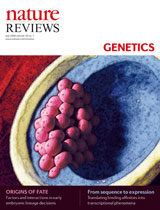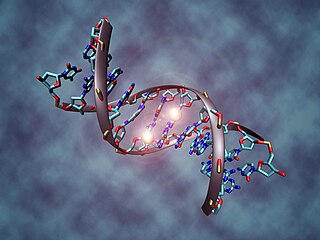Stem cell genomics analyzes the genomes of stem cells. Currently, this field is rapidly expanding due to the dramatic decrease in the cost of sequencing genomes. The study of stem cell genomics has wide reaching implications in the study of stem cell biology and possible therapeutic usages of stem cells. Application of research in this field could lead to drug discovery and information on diseases by the molecular characterization of the pluripotent stem cell through DNA and transcriptome sequencing and looking at the epigenetic changes of stem cells and subsequent products. One step in that process is single cell phenotypic analysis, and the connection between the phenotype and genotype of specific stem cells. While current genomic screens are done with entire populations of cells, focusing in on a single stem cell will help determine specific signaling activity associated with varying degrees of stem cell differentiation and limit background due to heterogeneous populations. [1] Single cell analysis of induced pluripotent stem cells (iPSCs), or stem cells able to differentiate into many different cell types, is a suggested method for treating such diseases like Alzheimer's disease (AD). This includes for understanding the differences between sporadic AD and familial AD. By first taking a skin sample from the patient and are transformed by transducing cells using retroviruses to encode such stem cell genes as Oct4, Sox2, KLF4 and cMYC. This allows for skin cells to be reprogrammed into patient-specific stem cell lines. [2] Taking genomic sequences of these individual cells would allow for patient-specific treatments and furthering understanding of AD disease models. This technique would be used for similar diseases, like amyotrophic lateral sclerosis (ALS) and spinal muscular atrophy (SMA). These stem cells developed from a singular patient would also be able to be used to produce cells affected in the above-mentioned diseases. As mentioned, it will also lead to patient specific phenotypes of each disease. Further chemical analyses to develop safer drugs can be done through sequence information and cell-culture tests on iPSCs. After development on a specific drug, it can be transferred to other patient diseased cells while also being safety tested. [3]

In the fields of molecular biology and genetics, a genome is the genetic material of an organism. It consists of DNA. The genome includes both the genes and the noncoding DNA, as well as mitochondrial DNA and chloroplast DNA. The study of the genome is called genomics.

In the fields of medicine, biotechnology and pharmacology, drug discovery is the process by which new candidate medications are discovered. Historically, drugs were discovered through identifying the active ingredient from traditional remedies or by serendipitous discovery. Later chemical libraries of synthetic small molecules, natural products or extracts were screened in intact cells or whole organisms to identify substances that have a desirable therapeutic effect in a process known as classical pharmacology. Since sequencing of the human genome which allowed rapid cloning and synthesis of large quantities of purified proteins, it has become common practice to use high throughput screening of large compounds libraries against isolated biological targets which are hypothesized to be disease modifying in a process known as reverse pharmacology. Hits from these screens are then tested in cells and then in animals for efficacy.

Deoxyribonucleic acid is a molecule composed of two chains that coil around each other to form a double helix carrying the genetic instructions used in the growth, development, functioning, and reproduction of all known living organisms and many viruses. DNA and ribonucleic acid (RNA) are nucleic acids; alongside proteins, lipids and complex carbohydrates (polysaccharides), nucleic acids are one of the four major types of macromolecules that are essential for all known forms of life.
Included in the study of stem cell genomics, is epigenomics, genomic-scale studies on chromatin regulatory variation. These studies also hope to expand research into regenerative medicine models and stem cell differentiation. Cell-type specific gene expression patterns during development occur as the result of interactions the chromatin level. Stem cell epigenomics focuses in on the epigenetic plasticity of human embryonic stem cells (hESCs). This includes investigation into bivalent domains as promoters or chromatin regions that are modified by transcriptional initiation and related to gene silencing. They are also looking at the differences between active versus poised enhancers or enhancers that specifically control signaling-dependent gene regulation. Active enhancers are marked by acetylation of histone H3-H3K27ac and while poised are instead methylated at H3K27me3. Stem cell epigenomic studies are also looking into DNA methylation patterns, specifically characteristics of hydroxy methylation versus overall methylation and the difference between methylation of CpG-island rich and CpG poor promoters. It has been found in mouse embryonic stem cells (mESC) that implanted mESC took up similar characteristics of histone methylation of the embryos where they transplanted into, indicating that methylation may be indicative of environment. This will guide studies into the differences between induced pluripotent and embryonic stem cells. These studies hope to produce information on iPSC differentiation capacity by first needing to enhance chormatin signature reading. It also hopes to produce to look into regulatory factors that control human embryonic development. [4] Using drug therapy techniques as mentioned earlier, epigenomics would also allow for more information on drug activity.
Epigenomics is the study of the complete set of epigenetic modifications on the genetic material of a cell, known as the epigenome. The field is analogous to genomics and proteomics, which are the study of the genome and proteome of a cell. Epigenetic modifications are reversible modifications on a cell's DNA or histones that affect gene expression without altering the DNA sequence. Epigenomic maintenance is a continuous process and plays an important role in stability of eukaryotic genomes by taking part in crucial biological mechanisms like DNA repair. Plant flavones are said to be inhibiting epigenomic marks that cause cancers. Two of the most characterized epigenetic modifications are DNA methylation and histone modification. Epigenetic modifications play an important role in gene expression and regulation, and are involved in numerous cellular processes such as in differentiation/development and tumorigenesis. The study of epigenetics on a global level has been made possible only recently through the adaptation of genomic high-throughput assays.

In genetics, a promoter is a region of DNA that initiates transcription of a particular gene. Promoters are located near the transcription start sites of genes, on the same strand and upstream on the DNA . Promoters can be about 100–1000 base pairs long.
Chromatin is a complex of DNA, RNA, and protein found in eukaryotic cells. Its primary function is packaging very long DNA molecules into a more compact, denser shape, which prevents the strands from becoming tangled and plays important roles in reinforcing the DNA during cell division, preventing DNA damage, and regulating gene expression and DNA replication. During mitosis and meiosis, chromatin facilitates proper segregation of the chromosomes in anaphase; the characteristic shapes of chromosomes visible during this stage are the result of DNA being coiled into highly condensed networks of chromatin.






